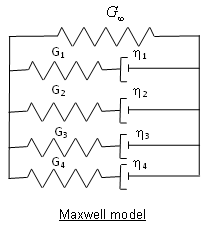MATX42 |

|

|

|

|
|
MATX42 |

|

|

|

|
Bulk Data Entry
MATX42 – Material Property Extension for Ogden, Mooney-Rivlin Material for Geometric Nonlinear Analysis
Description
Defines additional material properties for Ogden, Mooney-Rivlin material for geometric nonlinear analysis. This material is used to model rubber, polymers, and elastomers.
Format
(1) |
(2) |
(3) |
(4) |
(5) |
(6) |
(7) |
(8) |
(9) |
(10) |
MATX42 |
MID |
SCUT |
|
TBID |
FBULK |
|
|
|
|
|
LAW |
MU1 |
ALFA1 |
MU2 |
ALFA2 |
MU3 |
ALFA3 |
|
|
|
|
MU4 |
ALFA4 |
MU5 |
ALFA5 |
|
|
|
|
Optional continuation lines for prony value:
|
PRONY |
G1 |
T1 |
G2 |
T2 |
G3 |
T3 |
|
|
|
|
G4 |
T4 |
G5 |
T5 |
... |
|
|
|
|
Field |
Contents |
MID |
Material ID of the associated MAT1. See comment 1. No default (Integer > 0) |
SCUT |
Cut-off stress in tension. Default = 1030 (Real > 0) |
TBID |
Identification number of a TABLES1 to define the bulk function f(J) that scales the bulk modulus vs. relative volume. If TBID = 0, f(J) = const. = 1.0. Default = 0 (Integer > 0) |
FBULK |
Scale factor for bulk function. Default = 1.0 (Real > 0) |
LAW |
Indicates that material parameters MUi and ALFAi follow. |
MUi |
Parameter μi. Up to five pairs are permitted. (Real) |
ALFAi |
Parameter αi. Up to five pairs are permitted. (Real) |
PRONY |
Indicates that prony model parameters Gi and Ti follow. |
Gi |
Parameters Gi for prony model (Comments 7 and 8) (Real) |
Ti |
Parameter Ti for prony model (Comments 7 and 8) (Real) |
| 1. | The material identification number must be that of an existing MAT1 bulk data entry. Only one MATXi material extension can be associated with a particular MAT1. |
| 2. | MATX42 is only applied in geometric nonlinear analysis subcases which are defined by ANALYSIS = EXPDYN. It is ignored for all other subcases. |
| 3. | The recommended Poisson’s ratio for incompressible material is NU = 0.495. NU is defined on the corresponding MAT1. |
| 4. | The strain energy density W is computed using the following equation: |

Where, ![]() is the ith principal engineering stretch (
is the ith principal engineering stretch (![]() ,
, ![]() is the ith principal engineering strain). The Cauchy stress is computed as follows:
is the ith principal engineering strain). The Cauchy stress is computed as follows:

with J = λ1 * λ2 * λ3 being the relative volume:

The quantity, P is the pressure:
P = K * FBULK * f (J) * (J - 1)
The Bulk Modulus, K is:

with the ground shear modulus μ:

| 5. | An incompressible Mooney-Rivlin material is governed by: |
W = C10 (I1 - 3) + C01 (I2 - 3)
where, Ii is ith invariant of the right-hand Cauchy-Green Tensor. It can be modeled using the following parameters:
μ1 = 2 * C10
μ2 = -2 * C01
α1 = 2.0
α2 = -2.0
| 6. | Coefficients of the Prony series (Gi, Ti ) are used to describe viscous effects using the Maxwell model (which can be described in a simplified manner as a system of n springs with stiffness' Gi and dampers ηi): |

The hyperelastic ground shear modulus, ![]() is exactly the long-term shear modulus G∞ in the Maxwell model, and Ti is the relaxation time:
is exactly the long-term shear modulus G∞ in the Maxwell model, and Ti is the relaxation time:
![]()
The Gi and Ti values must be positive.
| 7. | Viscous effects are modeled through a convolution integral using Prony series. This is an extension of small strain theory (described in comment 6) to large nonlinear strain case. The Kirchhoff viscous stress is given by: |

with, F being the deformation gradient matrix, ![]() and
and ![]() denotes the deviatoric part of tensor
denotes the deviatoric part of tensor ![]() .
.
The viscous-Cauchy stress is written as:

| 8. | This card is represented as a material in HyperMesh. |
See Also: